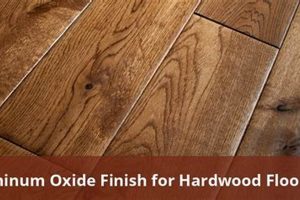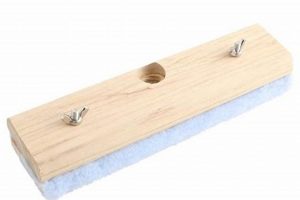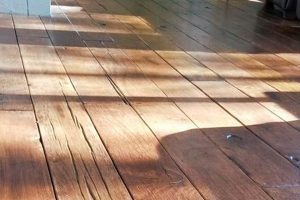Coatings designed for wooden surfaces, utilizing water as the primary solvent or carrier, are increasingly prevalent in the construction and remodeling sectors. These products form a protective layer on wood flooring, enhancing its durability and aesthetic appeal. They represent an alternative to solvent-based options, differing significantly in their chemical composition and application characteristics.
The growing adoption of these coatings stems from several advantages, including lower volatile organic compound (VOC) emissions, which contribute to improved indoor air quality and environmental sustainability. Historically, solvent-based products dominated the market; however, increasing awareness of health and environmental concerns has driven the demand for these eco-conscious alternatives. The resultant shift has influenced manufacturing processes and consumer preferences.
The following sections will explore the various types of these coatings, their application techniques, factors influencing their selection, and considerations for maintenance and long-term performance. This will provide a comprehensive understanding necessary for informed decision-making in residential and commercial flooring projects.
Application and Maintenance Guidelines
The following guidelines detail best practices for achieving optimal results when utilizing coatings of this type, and for ensuring their longevity on wood floors. Proper application and maintenance are critical for realizing the intended performance characteristics.
Tip 1: Substrate Preparation: Ensure the wood surface is clean, dry, and free of contaminants such as dust, grease, or previous coatings. Sanding may be required to achieve a smooth, even profile. A properly prepared surface promotes optimal adhesion and a uniform finish.
Tip 2: Product Selection: Choose a formulation appropriate for the intended use and traffic level. Consider factors such as durability, sheen, and resistance to scratching or abrasion. Selecting the correct product ensures long-term performance and satisfaction.
Tip 3: Application Technique: Apply the coating in thin, even coats using a high-quality applicator such as a brush, roller, or pad. Avoid over-application, which can lead to bubbling, sagging, or uneven drying. Multiple thin coats are generally preferable to a single thick coat.
Tip 4: Environmental Conditions: Maintain proper temperature and humidity levels during application and drying. Consult the manufacturer’s specifications for optimal conditions. Adverse conditions can negatively impact the curing process and the final finish quality.
Tip 5: Drying Time: Allow sufficient drying time between coats and before subjecting the floor to traffic. Follow the manufacturer’s recommended drying times. Premature use can damage the finish and compromise its durability.
Tip 6: Maintenance Procedures: Regularly clean the floor with a pH-neutral cleaner specifically designed for wood floors. Avoid harsh chemicals, abrasive cleaners, or excessive water, which can damage the finish. Implement preventative measures such as floor mats to minimize dirt and wear.
Tip 7: Recoating: Periodically recoat the floor to maintain its protective layer and aesthetic appeal. The frequency of recoating will depend on the traffic level and the severity of wear. Regular recoating extends the lifespan of the flooring and prevents costly repairs.
Following these guidelines will contribute to a successful application and ensure the long-term performance and beauty of the coated wood floor. Proper execution is paramount for maximizing the benefits of this type of flooring treatment.
The subsequent sections will address common issues encountered with these coatings and provide troubleshooting strategies for achieving a professional and lasting result.
1. Durability
Durability is a critical performance attribute of coatings for wooden floors that utilize water as the primary solvent. It encompasses the resistance of the applied film to wear, abrasion, impact, and chemical exposure. The inherent composition of these finishes, influenced by the resin chemistry and the addition of fortifying agents, directly affects its ability to withstand daily use and maintain its structural integrity over an extended period. For instance, coatings incorporating polyurethane or acrylic-urethane blends generally exhibit superior durability compared to pure acrylic formulations. The consequence of inadequate durability manifests as premature scratching, marring, and erosion of the protective layer, leading to the need for frequent recoating or, in severe cases, complete floor refinishing.
The relationship between the finish and the substrate it protects underscores the importance of selecting a product with appropriate durability characteristics. In high-traffic areas, such as hallways or commercial spaces, formulations designed for heavy use are essential to prevent rapid deterioration. The use of an inferior product in such environments inevitably results in compromised aesthetics and increased maintenance costs. Conversely, in low-traffic residential areas, a less robust, and potentially more economical, product may suffice. Real-world examples demonstrate that floors finished with high-durability products maintain their appearance and protective qualities for significantly longer periods, reducing the total cost of ownership despite the initial investment.
In summary, understanding the durability characteristics of these finishes is paramount for informed decision-making. The selection process should consider the intended use, expected traffic levels, and potential exposure to chemicals or abrasive substances. While achieving maximum durability may involve a higher initial cost, the long-term benefits, in terms of reduced maintenance and prolonged floor life, generally outweigh the expense. Ongoing research and development are focused on enhancing the durability of these products while minimizing their environmental impact, presenting a continuous evolution in flooring technology.
2. VOC Content
Volatile Organic Compounds (VOCs) represent a significant consideration when evaluating coatings designed for wood floors, especially those utilizing water as the primary solvent. The quantity and type of VOCs present in a finish directly impact indoor air quality, environmental compliance, and potential health implications. Understanding the relationship between VOC content and the properties of these finishes is crucial for both professional applicators and end-users.
- Regulatory Compliance
Governmental bodies impose stringent regulations regarding VOC emissions from various products, including wood floor coatings. Finishes exceeding established VOC limits may face restrictions on sale and use. Water-based formulas are often formulated to comply with these regulations, offering a solution for projects requiring adherence to specific environmental standards. Non-compliance can result in fines and project delays, highlighting the importance of selecting compliant products.
- Health Impacts
VOCs released during and after the application of floor coatings can negatively affect human health. Exposure to high concentrations of VOCs may cause respiratory irritation, headaches, nausea, and other adverse symptoms. Water-based options typically contain lower VOC levels than traditional solvent-based finishes, reducing the potential for harmful emissions and promoting healthier indoor environments. Schools, hospitals, and homes with sensitive occupants often prioritize low-VOC coatings for this reason.
- Environmental Considerations
The release of VOCs into the atmosphere contributes to air pollution and the formation of ground-level ozone, a major component of smog. Products with reduced VOC content help minimize these environmental impacts, aligning with sustainability initiatives and promoting responsible manufacturing practices. The adoption of water-based coatings supports efforts to reduce overall VOC emissions from the construction and remodeling industries.
- Performance Trade-offs
While water-based coatings generally offer lower VOCs, balancing VOC reduction with performance characteristics such as durability, drying time, and adhesion is crucial. Some formulations may require additives or specialized application techniques to achieve comparable performance to solvent-based counterparts. Research and development efforts continuously strive to improve the performance of low-VOC coatings without compromising their environmental benefits.
In conclusion, the VOC content of coatings for wood floors utilizing water as the primary solvent is a multifaceted consideration encompassing regulatory adherence, health consequences, environmental impact, and performance attributes. The increasing demand for environmentally responsible products has driven the development of low-VOC options that provide viable alternatives to traditional solvent-based finishes. Selecting a product with an appropriate VOC level is an essential step in ensuring a sustainable and healthy flooring solution. Further advancement in coating technology seeks to minimize VOCs without sacrificing crucial performance criteria.
3. Application Ease
The ease of application for coatings designed for wooden floors, particularly those utilizing water as the primary solvent, is a key factor influencing project outcomes and labor efficiency. This attribute encompasses various aspects of the application process, from preparation to cleanup, and significantly impacts the overall success of a flooring project.
- Viscosity and Leveling
The viscosity of the finish directly affects its spreadability and leveling characteristics. These coatings often exhibit lower viscosity compared to solvent-based counterparts, facilitating easier application with brushes, rollers, or spray equipment. Proper leveling ensures a smooth, uniform finish without brush marks or imperfections. A finish that levels effectively reduces the need for extensive sanding or rework, saving time and minimizing material waste.
- Odor and Ventilation Requirements
These products typically exhibit lower odor compared to traditional solvent-based finishes, reducing the need for extensive ventilation during application and curing. This characteristic allows for more convenient application in occupied spaces and minimizes disruption to occupants. Reduced odor also contributes to a more comfortable working environment for applicators, enhancing productivity and safety. However, adequate ventilation is still recommended to ensure proper drying and minimize potential exposure to any remaining volatile components.
- Cleanup Procedures
Cleanup procedures are significantly simplified with water-based coatings, requiring only water and soap for cleaning brushes, rollers, and other application equipment. This eliminates the need for harsh solvents, reducing disposal costs and minimizing environmental impact. Easier cleanup also translates to reduced labor time and a more streamlined workflow, contributing to overall project efficiency.
- Drying Time and Recoat Window
While earlier formulations sometimes exhibited longer drying times, advancements in resin technology have led to water-based products with drying times comparable to solvent-based options. The recoat window, or the time frame within which subsequent coats can be applied without requiring sanding, is a crucial factor influencing project timelines. A wider recoat window provides greater flexibility and reduces the risk of adhesion problems between coats. Careful adherence to the manufacturer’s recommendations regarding drying time and recoat windows is essential for achieving optimal results.
In conclusion, the ease of application associated with these coatings represents a significant advantage, contributing to reduced labor costs, improved project efficiency, and a more environmentally friendly application process. Factors such as viscosity, odor, cleanup procedures, and drying time all contribute to the overall applicably. These attributes, combined with ongoing advancements in coating technology, make them a viable and increasingly preferred choice for wood floor finishing applications.
4. Cure Time
The cure time of water-based wood floor finishes is a critical parameter that directly influences project timelines, the durability of the finished surface, and the overall success of a flooring application. Cure time refers to the period required for the finish to fully harden and achieve its designed performance characteristics, including resistance to abrasion, chemicals, and moisture. Water-based formulations, unlike solvent-based counterparts, rely on the evaporation of water and the coalescence of polymer particles to form a solid film. This process is intrinsically influenced by ambient temperature, humidity, and air circulation. Inadequate cure time can lead to a soft, easily damaged surface, compromising the integrity and longevity of the flooring. For example, prematurely placing furniture on a floor that has not fully cured can result in permanent indentations and surface marring.
The relationship between cure time and environmental factors is particularly significant for water-based finishes. High humidity levels can impede the evaporation of water from the coating, extending the cure time and potentially leading to issues such as clouding or reduced adhesion. Conversely, excessively high temperatures can cause the finish to dry too rapidly, resulting in cracking or incomplete film formation. Real-world applications demonstrate that closely monitoring and controlling environmental conditions during the curing process are essential for achieving optimal results. Furthermore, different water-based formulations exhibit varying cure times, influenced by the specific resin chemistry and the presence of additives. Understanding these nuances is crucial for selecting the appropriate finish for a given project and adhering to the manufacturer’s recommendations regarding cure time.
In summary, cure time is an indispensable component of water-based wood floor finishing, directly impacting the durability, appearance, and longevity of the finished floor. Failing to adhere to recommended cure times, or neglecting to control environmental factors, can lead to significant problems and necessitate costly repairs. By carefully considering these factors and following best practices, professionals and homeowners can ensure the successful application and long-term performance of water-based wood floor finishes. The ongoing development of faster-curing, more robust water-based formulations seeks to further mitigate the challenges associated with cure time, enhancing the practicality and reliability of these environmentally conscious flooring solutions.
5. Appearance (Sheen)
The resultant sheen of coatings designed for wooden floors, where water serves as the primary solvent, constitutes a critical element of their overall aesthetic impact. This aspect, ranging from matte to high gloss, directly influences the perception of the floor’s texture, color, and perceived cleanliness. The relationship between the specific water-based formulation and the final sheen level is complex, determined by factors such as the resin chemistry, the size and distribution of flattening agents (if any), and the application technique employed. For instance, a high-solids polyurethane finish, even when water-based, can achieve a significantly higher gloss level than a lower-solids acrylic, assuming both are designed for that purpose. The selected sheen level, in turn, must align with the intended use of the space, the architectural style of the building, and the preferences of the occupants. Incorrectly matching the sheen to the environment can diminish the perceived value of the flooring investment.
Real-world examples illustrate the practical significance of understanding this relationship. A matte finish, characterized by minimal light reflection, is often chosen for high-traffic areas to minimize the visibility of scratches and scuffs. Conversely, a high-gloss finish, reflecting a significant amount of light, can enhance the brightness of a room but also accentuate imperfections on the floor’s surface. In commercial settings, a satin finish is frequently selected as a compromise, offering a balance between durability and aesthetic appeal. The choice of sheen also impacts the maintenance requirements of the floor. High-gloss finishes, while visually striking, typically require more frequent cleaning and polishing to maintain their luster. The practical significance lies in the ability to select a product that not only provides adequate protection for the wood but also enhances the visual appeal of the space while minimizing long-term maintenance burdens.
In conclusion, the sheen level of coatings for wooden floors utilizing water as the primary solvent is a crucial design consideration that should not be overlooked. Careful attention to this detail ensures that the final flooring product aligns with both the aesthetic objectives of the project and the practical requirements of the environment. Challenges remain in consistently achieving the desired sheen level, particularly with water-based formulations, due to their sensitivity to application variables. However, ongoing advancements in coating technology continue to improve the predictability and control over sheen, further enhancing the versatility and appeal of water-based wood floor finishes.
Frequently Asked Questions About Water Based Wood Floor Finishes
The following section addresses common inquiries regarding the application, performance, and characteristics of coatings designed for wooden floors that utilize water as the primary solvent.
Question 1: Are water-based wood floor finishes as durable as solvent-based options?
Modern water-based formulations can achieve durability comparable to, and in some cases exceeding, that of traditional solvent-based finishes. Performance depends on the specific product chemistry, application technique, and maintenance practices. High-quality water-based polyurethanes, for instance, offer excellent resistance to abrasion, chemicals, and UV degradation.
Question 2: What are the primary advantages of using water-based wood floor finishes?
Key advantages include lower Volatile Organic Compound (VOC) emissions, reduced odor during application, easier cleanup with water, and faster drying times in many cases. These factors contribute to improved indoor air quality, a more environmentally friendly application process, and quicker project completion.
Question 3: Can water-based wood floor finishes be applied to all types of wood?
These coatings are generally compatible with most wood species. However, certain exotic or oily woods may require specific surface preparation techniques or the use of a sealer coat to ensure proper adhesion. Consulting the manufacturer’s recommendations is essential for optimal results.
Question 4: How does the application process differ from solvent-based finishes?
While the fundamental principles of floor finishing remain the same, water-based coatings typically require thinner coats and careful attention to drying times. The absence of strong solvents necessitates different application techniques and may require specialized applicators to achieve a smooth, uniform finish.
Question 5: What type of maintenance is required for floors finished with water-based coatings?
Regular cleaning with a pH-neutral wood floor cleaner is recommended. Avoid harsh chemicals, abrasive cleaners, and excessive water. Preventative measures, such as floor mats and furniture pads, can help minimize wear and extend the life of the finish.
Question 6: Are water-based wood floor finishes more expensive than solvent-based options?
The initial cost of water-based products can vary depending on the specific formulation and brand. However, factors such as reduced labor costs (due to easier cleanup and faster drying times) and lower long-term maintenance requirements can offset the initial investment. The long-term value proposition should consider both initial cost and lifecycle expenses.
Understanding these common questions provides a solid foundation for evaluating and utilizing coatings designed for wooden floors with water as the primary carrier. Careful consideration of these factors will lead to more informed decisions and more successful flooring projects.
The next section will delve into troubleshooting common issues encountered during the application process, providing practical solutions for achieving professional-quality results.
Conclusion
This exploration of coatings utilizing water as the primary solvent for wood floors has highlighted their significance as a viable and increasingly preferred alternative to traditional solvent-based products. The discussion encompassed the composition, advantages, application techniques, maintenance considerations, and common inquiries surrounding these finishes. Key points emphasized include their lower VOC emissions, comparable durability, simplified cleanup, and potential for faster drying times, contributing to environmentally responsible and efficient flooring solutions.
Continued research and development efforts are focused on further enhancing the performance characteristics of these coatings, ensuring their continued relevance and widespread adoption in both residential and commercial applications. A thorough understanding of their properties and proper application techniques remains crucial for achieving optimal results and maximizing the long-term value of wood flooring investments. The informed selection and responsible use of these products contribute to a more sustainable and healthier built environment.







